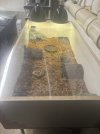Hortman81
New Member
I bought my two cherryheads as hatchlings over ten years ago. Luckily they ended up being a pair and I’ve recently hatched 8 eggs. The last two seasons I had eggs but none viable.
They spend the winter in this water land tub that’s being upgraded as you can see. The new enclosure is 8’x3’x18”. The hatchlings are in the mini version. Summertime they move outside into very large habitats with water features.
They spend the winter in this water land tub that’s being upgraded as you can see. The new enclosure is 8’x3’x18”. The hatchlings are in the mini version. Summertime they move outside into very large habitats with water features.




